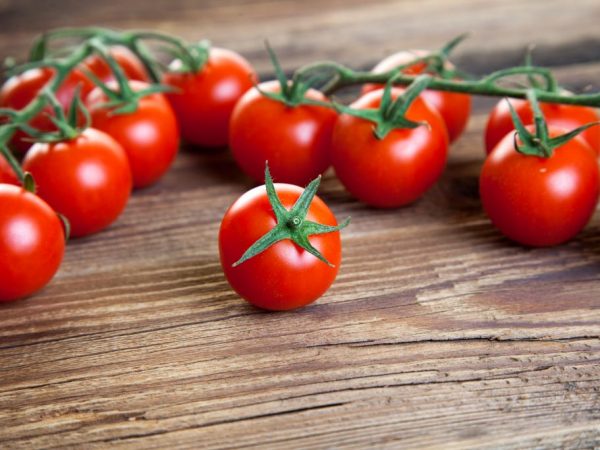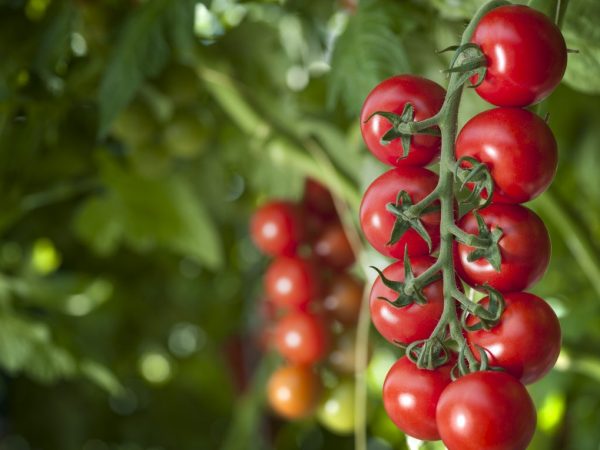Description and characteristics of the Bull's eye tomato
Despite its comparative novelty, the Bullseye tomato can already boast a very considerable and steadily growing popularity. And we must admit that this is quite natural, because this small-fruited variety, belonging to the category of "cherry" (also called cherry), has a number of remarkable characteristics. Its key difference from most other tomatoes is almost twice the content of dry nutrient ingredients that are dissolved in the extracellular juice. Other qualities of the presented tomato variety deserve attention, and therefore the latter simply needs to be considered in more detail.

Description and characteristics of the Bull's eye tomato
General characteristics
To begin with, it should be noted that the Bull's Eye owes its appearance to the specialists of the Siberian Garden agricultural firm, who managed to combine in it a considerable number of indisputable advantages, which will be discussed a little later. If we highlight the main features of the cherry tomato variety in question, then their list will look like this:
- Early ripening period, the standard value of which is 90-95 days.
- Liana-shaped stem, not distinguished by a high degree of foliage.
- Indeterminacy. In other words, the Bullseye is distinguished by unlimited growth, often exceeding the 2-meter mark. Practice shows that in a greenhouse, such bushes often run into the roof, and only pinching the top helps to stop their growth.
Plants belonging to this variety need a compulsory garter to support and pinching. As for the cultivation of such tomatoes, it is most rational to carry out it in protected ground. The validity of this thesis is confirmed both in the reviews of gardeners and in the recommendations distributed by the creators of the variety.
Sometimes the tomatoes in question are confused with the bull's forehead tomatoes. It is worth noting that apart from the common word in the name, they have little in common: in particular, the average weight of the latter is 250-300 g, while the Ox's eye berries weigh an order of magnitude less.
Features of fruits
As noted above, Bull's Eye tomatoes do not differ in impressive dimensions. On the contrary, they are quite miniature, and their weight rarely exceeds the 30-gram mark. It is worth noting that this characteristic is characteristic of all cherry tomatoes, which is why they are called cherry tomatoes. Among other features of the fruits of the presented variety, it is necessary to highlight the following:
- rounded shape;
- smooth glossy surface;
- deep red color (when the berries reach the ripeness stage);
- soft skin that can be eaten without any inconvenience.
Special attention should be paid to the fact that with each of the first two brushes it is possible to collect 10-12 such tomatoes, and from the next - many times more, up to 4 dozen. As for the use of Bullseye tomatoes, it can be very different, providing:
- fresh consumption;
- decoration of dishes;
- canning, etc.
In addition, the fruits are very popular among salad lovers, which is primarily due to their excellent gastronomic qualities.
Main advantages

Plant care won't be a hassle for you
The description of the variety in question would be incomplete if it did not include a listing of the most significant advantages of these cherry tomatoes. First of all, these are:
- excellent taste of tomatoes, primarily characterized by its sweetness;
- consistently high yield, subject to the basic rules of care;
- ease of cultivation, allowing you to achieve excellent results in the overwhelming majority of cases;
- high plasticity;
- beautiful appearance of the bushes, distinguished by a special decorative effect.
It is impossible not to mention the resistance of this variety to various diseases affecting tomatoes: it is high enough that any owner of such plants will appreciate it. Another benefit of these cherry tomatoes is the increased lycopene and sugar content in excess of 4.5%. The first is a first-class antioxidant, and the second is an excellent source of energy, as a result of which the Bullseye is reasonably considered one of the most useful varieties of tomatoes for the human body.
Growing features
Among all the points that it is desirable to take into account for each owner of the shrubs of the variety in question, special attention should be paid to the soil. Experience has shown that it must be well drained and neutral to achieve optimal yield. As for other recommendations that can benefit everyone who wants to grow Bullseye tomatoes, they are presented below:
- Sowing seeds for seedlings should be carried out 2 months before the planned planting in the ground, with a maximum permissible deviation not exceeding 5 days.
- The picking of seedlings should be carried out after the plants acquire the first full-fledged leaves.
- So that over time the growing bushes do not begin to interfere with each other, it makes sense to maintain a certain distance between them. Experts advise placing these plants so that 1 sq. m there were no more than 3 pieces.
In a brush, such tomatoes ripen almost simultaneously, and the owner of the plants can harvest the harvest at his own discretion - picking off both clusters of berries and individual fruits.
In order to get the best result, experienced gardeners are advised to form Bullseye tomato bushes in 2 or 3 stems.
Common problems and solutions
Fortunately, the Bull's Eye is not highly susceptible to pathogens of certain diseases of tomatoes, for which, first of all, one should thank the breeders who created it. At the same time, the tomatoes in question are not completely invulnerable, sometimes suffering from such common misfortunes as:
- Late blight. This fungal disease is characterized by gray-brown spots that appear first on the foliage, and then on the stems and berries of the plant. If proper measures are not taken, this ailment will lead to the loss of most of the crop, especially actively developing in warm and humid conditions.
- Alternaria The second name of the disease in question, which is also fungal, is brown or dry spotting. It affects all aboveground organs of tomato bushes, spreading from the bottom up. Most often, the disease occurs in greenhouse conditions, being able to destroy up to 2/3 of the crop.
Given the fungal origin of both ailments, you can fight them with the same means. These are fungicides of a wide spectrum of action, the effectiveness of which in countering such infections is beyond doubt (provided that measures are taken in a timely manner).One of these drugs that can "boast" the best performance is Ordan, which can be used both for the total extermination of a microscopic threat and for prevention purposes.


